Does your mozzarella refuse to stretch or just burn? The secret is science. From "pasta filata" to the crucial role...
The Hive's Hidden Treasure
Propolis's Intelligent Battle Against Cancer
In the heart of every beehive flows a resilient and vibrant city; a city that requires a flawless defense system for its survival. The guardian of this city is a marvelous, sticky, and aromatic substance: propolis. This material, created from an intelligent combination of tree resins, beeswax, and honeybee enzymes, forms an invisible shield against the invasion of bacteria, viruses, and fungi. But the mission of propolis extends beyond protecting the hive. For thousands of years, humanity has recognized the healing power of this substance, and now, modern science is unveiling its most astonishing ability: its unique potential to fight one of the most complex diseases of our time, cancer. This article is a deep dive into the world of this extraordinary substance to discover how this "bee glue" can become a strategic ally in the battle against cancer.

A Journey Through History: From the Egyptian Pyramids to Modern Laboratories
The word "Propolis" has Greek roots: "Pro" meaning "in defense of" and "Polis" meaning "city." This naming itself is a testament to the profound understanding our ancestors had of this substance's function. The footprint of propolis use in human history is a fascinating story of wisdom and experience:
The Hive's Pharmacy: A Chemical Autopsy of Propolis
The power of propolis is not summarized in a single compound; rather, it is the result of an amazing "synergy" among hundreds of biologically active molecules. Like the notes of a symphony, these compounds together create an effect far more powerful than the impact of each one alone. The chemical composition of propolis is highly dependent on the plant geography (flora), season, and even the bee species. This diversity has led to the emergence of different types of propolis with unique characteristics:
Another crucial point is the extraction method. The active compounds of propolis must be separated from its raw mass by a suitable solvent. The most common solvent is ethanol, which can extract a wide range of flavonoids and phenolics. However, extraction with water, glycerin, or oil are other methods, each yielding a different profile of compounds. Therefore, the quality and type of propolis extract directly impact its therapeutic properties.
A Multi-Pronged Strategy: How Propolis Fights Cancer
Cancer is not a one-dimensional disease; it is a collection of complex processes that allow cells to proliferate indefinitely, escape death, create their own blood supply, and invade other parts of the body. The beauty of propolis's action is that, unlike some chemotherapy drugs that have only a single target, this natural substance simultaneously attacks multiple fronts in this war.
Halting Proliferation (Cell Cycle Arrest)
The life cycle of a cancer cell is a rapid, vicious cycle of growth and division. This cycle is controlled by proteins called cyclins and cyclin-dependent kinases (CDKs), which act like a gas pedal. Propolis compounds, especially CAPE and Artepillin C, inhibit these proteins, effectively putting their foot on the brake and stopping the cell at a checkpoint. Furthermore, propolis can reawaken tumor suppressor genes like p53 and p21 that are inactivated in cancer cells. These genes act as the cell's natural brakes, and their reactivation means a complete halt to tumor growth.
Inducing Cell Suicide (Apoptosis)
Cancer cells have learned the art of escaping death. Propolis nullifies this art. This is done through two main pathways: the intrinsic (mitochondrial) pathway, where propolis induces oxidative stress, disrupting the balance between death proteins (Bax) and life proteins (Bcl-2). This leads to the release of cytochrome C from the mitochondria and the activation of a cascade of executioner enzymes called caspases. The extrinsic (death receptor) pathway, where propolis compounds make cancer cells more sensitive to death signals sent from immune cells. They increase the number of death receptors (like TRAIL) on the cell surface, making it more prepared to receive the suicide command.
Cutting Off the Tumor's Supply Line (Anti-Angiogenesis)
For a tumor to grow beyond a microscopic size, it requires oxygen and nutrients. To achieve this, it sends signals (the most important being VEGF) to attract new blood vessels. This process is called angiogenesis. Propolis is a potent anti-angiogenic agent. Its compounds directly inhibit VEGF production by cancer cells and also prevent the growth of new blood vessel wall cells. This strategy places the tumor under an economic siege, starving it and preventing its further growth.
Blocking the Path of Invasion (Anti-Metastasis)
The most dangerous feature of cancer is its ability to metastasize, or spread to other organs. To do this, cancer cells must detach from the primary tumor, invade surrounding tissues, and enter the bloodstream or lymphatic system. This process requires enzymes called matrix metalloproteinases (MMPs), which act like molecular scissors, clearing the path for invading cells. Propolis strongly inhibits the activity of these enzymes. By affecting cell adhesion molecules, it also strengthens the connection between cancer cells, preventing their escape. This reduces the risk of metastasis and the progression of the disease to later stages.

An Intelligent Partnership: Propolis Alongside Conventional Treatments
Perhaps one of the most exciting and practical aspects of research is the role of propolis as a complementary and integrative therapy. Propolis not only does not interfere with standard treatments but can also enhance their effectiveness and reduce their side effects:
"Please note: Propolis is not a magic drug or a substitute for standard cancer treatments. It is a powerful natural ally that should be used under the supervision and consultation of a medical team, especially an oncologist, as part of a comprehensive and integrative treatment approach. The quality and standardization of the product are also of utmost importance."





















Latest comments